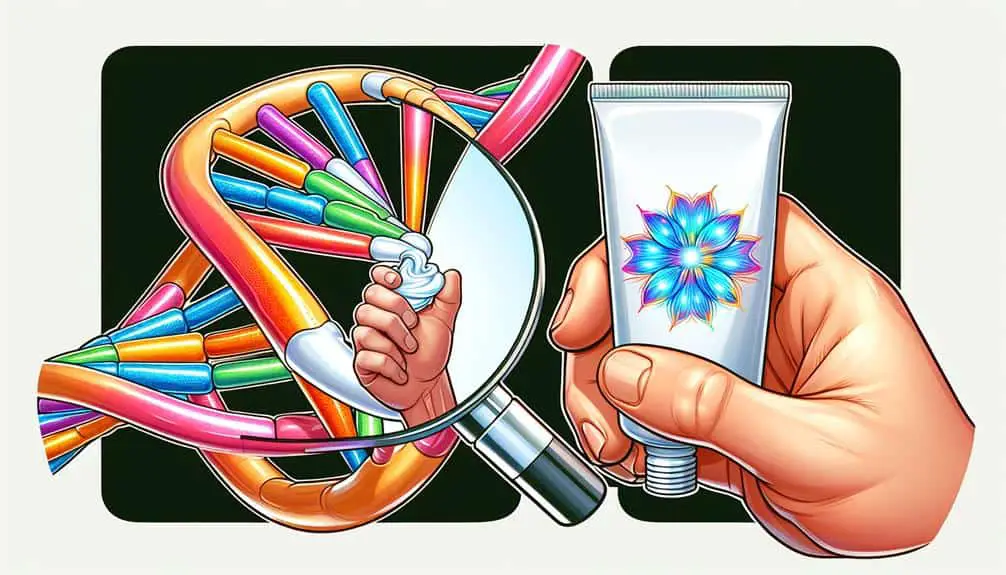Master genetic discoloration whitening by understanding triggers and selecting effective whitening products. Prioritize safety and proven ingredients like hydrogen peroxide and potassium nitrate. Develop a consistent routine with daily oral care and lifestyle adjustments. Seek guidance from dental professionals for personalized treatment plans and advanced options. Monitor progress, follow care instructions, and maintain good oral hygiene for lasting results. Learn more about the precise methods needed for successful genetic discoloration whitening.
Key Points
- Understand genetic factors influencing discoloration triggers and melanin production for effective treatment.
- Choose clinically proven whitening products with safe and active ingredients like hydrogen peroxide for genetic discoloration.
- Establish a consistent whitening routine with daily oral care and lifestyle adjustments for optimal results.
- Seek guidance from dental professionals for personalized treatment recommendations and access to advanced whitening options.
- Monitor progress, follow post-whitening care, and maintain good oral hygiene for sustained whitening success.
Understanding Genetic Discoloration Causes
To understand the causes of genetic discoloration, examine the specific variations in genes that contribute to the manifestation of this condition. Genetic factors play an important role in determining an individual's predisposition to discoloration triggers. These genetic variations can impact the production of melanin, the pigment responsible for skin color, leading to uneven pigmentation and discoloration issues.
Certain genes involved in melanin synthesis, distribution, and regulation can be inherited, influencing how melanin is produced and distributed in the skin. Discoloration triggers, such as exposure to UV radiation, hormonal changes, and environmental factors, can exacerbate genetic discoloration by stimulating melanocytes to produce more melanin.
Understanding the intricate interplay between genetic factors and external triggers is essential in devising effective whitening strategies for genetic discoloration. By targeting the specific genes and pathways involved in melanin production and distribution, tailored treatments can be developed to address the root cause of genetic discoloration and achieve best results.
Choosing the Right Whitening Products
Picking the right whitening products is crucial in effectively managing genetic discoloration. When choosing products for genetic discoloration whitening, prioritize product effectiveness and ingredient safety. Seek out whitening products that contain active ingredients such as hydrogen peroxide, carbamide peroxide, or whitening agents like potassium nitrate and fluoride. These components are recognized for their efficacy in breaking down stains and brightening teeth. Make sure that the products you select are clinically proven to be effective in addressing genetic discoloration specifically.
Furthermore, ingredient safety is paramount when it comes to whitening products. Steer clear of products that include harsh abrasives or chemicals that can harm enamel or cause sensitivity. Opt for whitening products that have been tested and endorsed by dental associations to be safe for long-term use. Always review the labels and instructions to comprehend the ingredients and potential side effects. By choosing whitening products with both product effectiveness and ingredient safety in mind, you can effectively combat genetic discoloration and achieve a brighter, whiter smile.
Implementing Consistent Whitening Routine
For an effective genetic discoloration whitening regimen, establishing a consistent routine is crucial. Consistency is key in achieving long-lasting results. Consider the following to enhance your whitening routine:
- Daily Brushing and Flossing: Maintaining good oral hygiene practices is essential for successful whitening. Brush at least twice a day with a fluoride toothpaste and floss regularly to prevent stains from settling on your teeth.
- Lifestyle Changes: Certain habits like smoking, consuming staining foods and beverages, and neglecting oral care can impede whitening progress. Making lifestyle adjustments such as quitting smoking, moderating coffee intake, and staying hydrated can greatly impact the effectiveness of your whitening routine.
- Regular Whitening Schedule: Stick to a consistent whitening schedule as recommended by your dental professional or the whitening product instructions. Consistency in applying whitening products ensures that your teeth receive the treatment they need to combat genetic discoloration effectively.
Implementing these strategies diligently will support your genetic discoloration whitening journey and help you achieve the desired results.
Consulting With a Dental Professional
When seeking ideal genetic discoloration whitening outcomes, engaging with a dental professional is essential for personalized guidance and effective treatment recommendations. A dental professional can provide valuable professional advice tailored to your specific genetic discoloration issues. They'll assess your dental health, evaluate the extent of discoloration, and recommend suitable treatment options. Consulting with a dental professional ensures that you receive expert guidance on the most appropriate whitening techniques based on your individual needs.
Dental professionals have access to a range of advanced treatment options that may not be available over the counter. They can recommend in-office whitening procedures or provide custom-fitted whitening trays for at-home use. By consulting with a dental professional, you can benefit from their expertise in determining the safest and most effective whitening approach for your genetic discoloration. Additionally, they can monitor your progress and make any necessary adjustments to achieve excellent results. Trusting in the guidance of a dental professional is a critical step towards achieving successful genetic discoloration whitening.
Monitoring Whitening Progress and Maintenance
Consistently evaluating the progress of your whitening treatment and implementing a maintenance plan is crucial for best results. Daily monitoring of your whitening progress allows for adjustments to be made promptly. Long term upkeep is essential to sustain the achieved results over time.
To guarantee the success of your whitening treatment, consider the following:
- Whitening Progress Tracking: Regularly document the shade changes in your teeth to objectively measure the effectiveness of the treatment. This tracking can help you identify any plateauing in progress and decide on the next steps accordingly.
- Maintenance Tips: Maintain good oral hygiene practices and follow any post-whitening care instructions provided by your dental professional. This can include using touch-up whitening treatments or specific toothpaste to prevent staining and preserve the whiteness of your teeth.
- Daily Monitoring: Keep an eye on any potential discoloration or staining factors in your daily routine, such as coffee consumption or smoking, and adjust your habits to prolong the whitening effects.
Frequently Asked Questions
Can Genetic Discoloration Be Completely Eliminated Through Whitening Treatments?
Genetic discoloration may not disappear completely with whitening treatments. The efficacy of these treatments can vary due to genetic factors. Success in eliminating genetic discoloration through whitening might be limited, requiring customized approaches for best results.
Are There Any Long-Term Side Effects of Using Whitening Products for Genetic Discoloration?
As you navigate the domain of whitening for genetic discoloration, consider the potential long-term effects. Balancing risks and benefits is essential. Stay vigilant and consult professionals to safeguard against any unforeseen consequences on your oral health.
How Can Genetics Impact the Effectiveness of Whitening Treatments for Discoloration?
Genetic predisposition plays an essential role in determining whitening effectiveness for discoloration treatments. Understanding your genetic makeup can help tailor treatments for best results. Consult with professionals to develop a personalized plan based on genetic factors.
Are There Any Specific Dietary or Lifestyle Changes That Can Help Maintain Whitening Results for Genetic Discoloration?
To maintain whitening results for genetic discoloration, dietary adjustments and lifestyle modifications are vital. Focus on consuming foods low in pigments that stain teeth and adopt good oral hygiene practices for long-lasting effects.
Can Genetic Discoloration Worsen Over Time, Even With Consistent Whitening Routines?
Genetic discoloration progression can persist despite consistent whitening routines due to underlying genetic factors. The effectiveness of treatments may vary based on individual genetic predispositions. Understanding these complexities is important for managing genetic discoloration over time.



